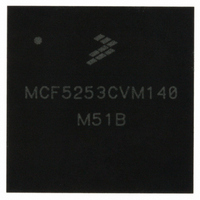MCF5253CVM140 Freescale Semiconductor, MCF5253CVM140 Datasheet - Page 335

MCF5253CVM140
Manufacturer Part Number
MCF5253CVM140
Description
IC MPU 32BIT 140MHZ 225-MAPBGA
Manufacturer
Freescale Semiconductor
Series
MCF525xr
Datasheets
1.MCF5253VM140J.pdf
(34 pages)
2.MCF5253VM140J.pdf
(8 pages)
3.MCF5253VM140J.pdf
(648 pages)
4.MCF5253VM140J.pdf
(2 pages)
Specifications of MCF5253CVM140
Core Processor
Coldfire V2
Core Size
32-Bit
Speed
140MHz
Connectivity
CAN, EBI/EMI, I²C, QSPI, UART/USART, USB OTG
Peripherals
DMA, WDT
Program Memory Type
ROMless
Ram Size
128K x 8
Voltage - Supply (vcc/vdd)
1.08 V ~ 1.32 V
Data Converters
A/D 6x12b
Oscillator Type
External
Operating Temperature
-40°C ~ 85°C
Package / Case
225-MAPBGA
Family Name
MCF5xxx
Device Core
ColdFire V2
Device Core Size
32b
Frequency (max)
140MHz
Instruction Set Architecture
RISC
Supply Voltage 1 (typ)
1.2/3.3V
Operating Supply Voltage (max)
1.32/3.6V
Operating Supply Voltage (min)
1.08/3V
Operating Temp Range
-40C to 85C
Operating Temperature Classification
Industrial
Mounting
Surface Mount
Pin Count
225
Package Type
MA-BGA
Lead Free Status / RoHS Status
Lead free / RoHS Compliant
Number Of I /o
-
Eeprom Size
-
Program Memory Size
-
Lead Free Status / Rohs Status
Compliant
Available stocks
Company
Part Number
Manufacturer
Quantity
Price
Company:
Part Number:
MCF5253CVM140
Manufacturer:
FREESCALE
Quantity:
300
Company:
Part Number:
MCF5253CVM140
Manufacturer:
Freescale Semiconductor
Quantity:
10 000
Part Number:
MCF5253CVM140
Manufacturer:
FREESCALE
Quantity:
20 000
Company:
Part Number:
MCF5253CVM140J
Manufacturer:
Freescale Semiconductor
Quantity:
10 000
- MCF5253VM140J PDF datasheet
- MCF5253VM140J PDF datasheet #2
- MCF5253VM140J PDF datasheet #3
- MCF5253VM140J PDF datasheet #4
- Current page: 335 of 648
- Download datasheet (8Mb)
17.7.7.4
Usually, the processor will run an audio interrupt routine. Every time the audio interrupt routine runs, it
will process 2, 3, or 4 audio samples, and send this many samples to one or more PDOR output registers.
Also, the audio interrupt routine will read one or more PDIR registers until empty.
In the audio interrupt routine, typically at the beginning, the PDIR registers are read until empty, while the
PDOR registers are written at the end of the routine when all calculations are completed. Due to this
calculation latency, there is a delay between entering the audio interrupt routine and the filling of the
transmit FIFOs.
Due to this delay, it is difficult to “fire” the audio interrupt routine on a transmit FIFO empty interrupt.
Because of the extra delay before the data is written, the transmit
written.
To make it easy for the programmer, the audioTick interrupt was added. To start the audio interrupt routine,
use the following sequence:
The transmit FIFOs have a special feature. After the software releases the reset to them, they will stay in
reset until the audio Interrupt Routine writes data to them for the first time. So, during Step 2 of above
mentioned start-up procedure, all transmit FIFO’s are set in reset, with one sample remaining. They will
stay in this state, until the audio Interrupt Routine writes data to them. At this point in time, they are then
filled up with an extra 2, 3, or 4 samples to a total of 3, 4, or 5 samples. Also, the first data write to the
FIFOs releases the reset, and starts transmission of the FIFO data on the corresponding transmit output.
(IIS1, IIS2 or IEC958). The next time that data is written to the FIFO’s in the audioTick interrupt routine,
2,3, or 4 samples have been transmitted and the FIFO is ready to accept new data.
To work properly, the jitter from one audioTick write point to the next is important. Jitter should be lower
than 1 sample period if data is written in groups of 2 or 3 samples to the transmit FIFOs, and lower than
1/2 sample period if data is written in groups of 4 samples to the transmit FIFOs.
The receive FIFO’s (PDIR’s) don’t have an auto-reset-de-assert mechanism, and should be released out of
reset just before enabling audioTick interrupt.
Figure 17-19
interrupts. Each FIFO holds up to six audio samples (left and right).
The Empty Interrupt occurs when there is still one right sample left to be transmitted, thus giving the
system one audio sample length to fill the FIFO back-up. The Underrun Interrupt occurs when there are
no samples left to be transmitted. While this is a situation that should be taken seriously, it will rarely occur,
if at all. However, should this happen, the system will continue to repeat the last sample until the FIFO
buffer has new data.
Freescale Semiconductor
1. Reset the transmit FIFOs
2. Program the transmit FIFOs to the correct source, then release the reset on transmit FIFOs
3. Reset the PDIR FIFOs
4. Load audio interrupt routine in on-chip SRAM
5. Release reset for the PDIR FIFOs and enable audioTick interrupt
Audio Interrupt Routines and Timing
shows the timing (relative to the Word Clock) of the Empty, Under-run, and Audio Tick
MCF5253 Reference Manual, Rev. 1
FIFO
will underrun before any data is
Audio Interface Module (AIM)
17-37
Related parts for MCF5253CVM140
Image
Part Number
Description
Manufacturer
Datasheet
Request
R
Part Number:
Description:
Mcf5253 Coldfire? Microprocessor Data Sheet
Manufacturer:
Freescale Semiconductor, Inc
Datasheet:
Part Number:
Description:
Manufacturer:
Freescale Semiconductor, Inc
Datasheet:
Part Number:
Description:
Manufacturer:
Freescale Semiconductor, Inc
Datasheet:
Part Number:
Description:
Manufacturer:
Freescale Semiconductor, Inc
Datasheet:
Part Number:
Description:
Manufacturer:
Freescale Semiconductor, Inc
Datasheet:
Part Number:
Description:
Manufacturer:
Freescale Semiconductor, Inc
Datasheet:
Part Number:
Description:
Manufacturer:
Freescale Semiconductor, Inc
Datasheet:
Part Number:
Description:
Manufacturer:
Freescale Semiconductor, Inc
Datasheet:
Part Number:
Description:
Manufacturer:
Freescale Semiconductor, Inc
Datasheet:
Part Number:
Description:
Manufacturer:
Freescale Semiconductor, Inc
Datasheet:
Part Number:
Description:
Manufacturer:
Freescale Semiconductor, Inc
Datasheet:
Part Number:
Description:
Manufacturer:
Freescale Semiconductor, Inc
Datasheet:
Part Number:
Description:
Manufacturer:
Freescale Semiconductor, Inc
Datasheet:
Part Number:
Description:
Manufacturer:
Freescale Semiconductor, Inc
Datasheet:
Part Number:
Description:
Manufacturer:
Freescale Semiconductor, Inc
Datasheet:











